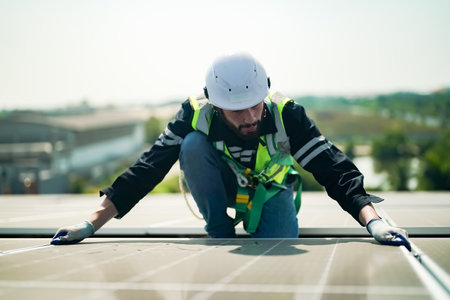1. Understanding the UK Solar Panel Landscape in 2025
As the United Kingdom accelerates its journey towards net zero, solar energy adoption continues to surge in 2025. Homeowners are increasingly turning to photovoltaic (PV) panels as a means to reduce electricity bills and lower carbon footprints. The British government remains committed to supporting renewable energy, with updated policies and incentives aimed at making solar installations more accessible for residential properties across England, Scotland, Wales, and Northern Ireland.
Government Priorities for Solar Energy
The UK government’s priorities focus on expanding green infrastructure and encouraging households to participate in the clean energy transition. This is reflected in the commitment to phase out fossil fuel reliance and increase the share of renewables within the national grid. Solar power forms a crucial pillar in this strategy, both for its scalability and its compatibility with urban and rural settings alike.
Regulatory Climate for Residential Solar Installations
Regulations surrounding domestic solar installations have evolved to streamline processes while maintaining rigorous safety standards. Most residential projects now fall under ‘permitted development rights,’ which removes the need for planning permission in many cases—provided certain size and placement criteria are met. Additionally, updates to building regulations ensure that new systems are safe, efficient, and future-proofed for smart grid integration.
Current State of Solar Energy Adoption: Key Statistics
| Region | % of Homes with Solar Panels (2025) | Recent Growth Rate (Year-on-Year) |
|---|---|---|
| England | 12% | +3% |
| Scotland | 10% | +2.5% |
| Wales | 9% | +2% |
| Northern Ireland | 7% | +1.8% |
This evolving landscape means homeowners looking to invest in solar PV can benefit from a supportive regulatory framework and a growing pool of financial incentives—making 2025 an opportune year to consider installation. With ongoing advances in technology and a favourable policy environment, the stage is set for even broader adoption across the UK.
2. Government Grants Available for Solar Panel Installation
As the UK continues its push towards net zero emissions, 2025 brings a host of government grants and financial incentives designed to make solar panel installation more affordable for homeowners across England, Scotland, Wales, and Northern Ireland. Understanding these schemes, their eligibility criteria, and the application process can help you maximise your savings when investing in solar technology.
National Grants and Schemes
| Scheme Name | Description | Eligibility Criteria | Support Provided |
|---|---|---|---|
| ECO4 (Energy Company Obligation) | A government-backed scheme requiring large energy suppliers to fund energy efficiency improvements, including solar panels, for eligible households. | Low-income households; receipt of certain benefits such as Universal Credit or Pension Credit; properties with poor energy efficiency ratings. | Partial or full funding for solar PV installation; support varies by supplier and region. |
| Home Upgrade Grant Phase 2 (HUG2) | Targets homes off the gas grid in England with low energy efficiency. Includes funding for solar PV and battery storage. | Owner-occupiers or private renters in fuel poverty; EPC rating D-G; not connected to mains gas. | Grants of up to £10,000 per property (varies by local authority). |
| Smart Export Guarantee (SEG) | Requires licensed electricity suppliers to pay small-scale generators (like homeowners with solar panels) for surplus electricity exported to the grid. | No income restrictions; must have a smart meter and MCS-certified installation. | Export tariffs paid per kWh exported; rate set by individual suppliers. |
Local Authority Initiatives in 2025
Many councils are offering top-up grants or exclusive schemes on top of national programmes. These may include zero-interest loans, additional grants for combining solar PV with insulation upgrades, or group-buying initiatives like “Solar Together.” It’s important to check with your local authority as offers differ widely across regions.
How to Apply for Government Solar Grants
- Check Eligibility: Use online tools such as the government’s Simple Energy Advice website or contact your local council’s energy team to confirm your eligibility for specific grants or schemes.
- Gather Documentation: Typically, you’ll need proof of home ownership/tenancy, benefit entitlement (if applicable), recent EPC certificate, and details about your property’s current heating system.
- Select an Approved Installer: Ensure you use an MCS-certified installer—this is required for grant approval and access to the SEG tariff.
- Submit Your Application: For national schemes like ECO4 and HUG2, applications are generally handled through registered installers who will help you complete paperwork and liaise with grant administrators. For local schemes, follow guidance on your council’s website.
- Await Assessment & Approval: Your property may be assessed for suitability before funding is granted. Once approved, installation can proceed with costs covered according to your grant offer.
Your Next Steps
If you’re considering solar panels in 2025, take advantage of both national and local government support. Start by exploring which grants apply in your area and act early—funding windows can be limited and highly competitive!

3. Financial Incentives and Schemes to Offset Costs
When considering the installation of solar panels in the UK, understanding the array of financial incentives available is crucial for maximising your savings in 2025. Several government-backed schemes and tax reductions are currently in place to make solar energy more accessible and affordable for homeowners and businesses alike.
Smart Export Guarantee (SEG)
The Smart Export Guarantee (SEG) is a key initiative that allows small-scale generators of renewable electricity, such as solar panel owners, to receive payments for excess electricity exported back to the National Grid. Under SEG, energy suppliers with over 150,000 customers are obligated to offer tariffs that pay you for every kilowatt-hour (kWh) you export. This provides a steady income stream and shortens the payback period for your investment.
Current SEG Providers and Example Tariffs
| Provider | Tariff Name | Export Rate (p/kWh) |
|---|---|---|
| Octopus Energy | Outgoing Fixed | 15 |
| E.ON Next | Next Export Exclusive | 16.5 |
| OVO Energy | OVO SEG Tariff | 4 |
VAT Reductions on Solar Installations
Another significant benefit is the reduced VAT rate on solar panel installations. As of April 2022, the UK government has set the VAT at 0% for domestic solar panel systems until March 2027. This measure directly lowers the upfront cost of purchasing and installing solar equipment, ensuring that more households can afford to transition to renewable energy sources.
VAT Comparison Table
| Year Installed | Standard VAT Rate (%) | Discounted VAT Rate (%) | Savings on £6,000 System (£) |
|---|---|---|---|
| 2021 or Earlier | 5% | N/A | £300 (added cost) |
| 2022–2027 | N/A | 0% | £0 (full savings) |
Additional Rebates and Regional Grants
Certain local authorities across England, Scotland, Wales, and Northern Ireland also offer additional rebates or grants for eligible residents who install solar panels. These regional schemes may cover part of the installation costs or provide low-interest loans to encourage green energy adoption. Availability varies by council, so it is advisable to check with your local authority for current offers before committing to an installation.
The combined impact of these financial incentives makes solar power not only environmentally responsible but also economically attractive for UK residents looking ahead to 2025.
4. How to Successfully Apply: Tips for Homeowners
Understanding the Application Process
Applying for grants and incentives for solar panel installation in the UK can seem daunting, but a clear approach will help maximise your chances of success. The process typically involves registering your interest, submitting an application with supporting documents, and complying with scheme-specific requirements. Thorough preparation ensures you avoid delays and make the most of available savings in 2025.
Required Documentation Checklist
| Document | Description | Tips for Submission |
|---|---|---|
| Proof of Ownership | Title deeds or mortgage statement showing you own the property | Ensure details match your application exactly |
| ID Verification | Passport or driving licence (photocopy or scan) | Check that documents are valid and not expired |
| Energy Performance Certificate (EPC) | A current EPC showing property energy rating | Book an assessment if your certificate is out of date |
| Installation Quote | Detailed quote from an MCS-certified installer | Include breakdown of costs and system specifications |
| Planning Permission (if required) | Council approval letter (if needed for your property type) | Verify if your home is listed or in a conservation area first |
| Bank Details | For receiving grant funds or incentive payments | Double-check account numbers for accuracy |
Common Pitfalls to Avoid
- Selecting Uncertified Installers: Always choose an installer registered with the Microgeneration Certification Scheme (MCS) to ensure eligibility.
- Incomplete Documentation: Missing paperwork is a leading cause of rejected applications. Use the checklist above to confirm you have everything required.
- Poor Timing: Submit applications as early as possible, especially when funding rounds open, as some schemes operate on a first-come, first-served basis.
- Lack of Compliance Awareness: Failing to meet building regulations or local planning requirements can result in denied grants or penalties.
Meeting UK Standards and Compliance Requirements
Your solar installation must adhere to UK standards for safety, performance, and efficiency. Ensure your chosen installer is MCS-accredited and that all works comply with Part P of the Building Regulations. For homes in Scotland or Northern Ireland, check any additional regional requirements. Upon completion, request all certificates and warranties, including the MCS certificate, which may be necessary for future incentives like Smart Export Guarantee (SEG) payments.
If You Need Support: Useful Contacts
| Organisation | Support Provided |
|---|---|
| MCS Helpdesk | Guidance on certified installers & standards (mcscertified.com) |
| Your Local Council Planning Office | Advice on permissions and compliance in your area |
| The Energy Saving Trust | Schemes advice & impartial information (energysavingtrust.org.uk) |
A Final Tip:
Keep copies of all correspondence and receipts throughout the process—these may be needed for audits or future applications.
5. Maximising Long-Term Savings and Return on Investment
Leveraging Grants and Incentives for Immediate Savings
Securing both grants and incentives is a strategic way to reduce the upfront costs of solar panel installation in the UK. By combining available government schemes—such as the Smart Export Guarantee (SEG) and VAT reductions—with local council grants, homeowners can significantly lower their initial outlay. This approach not only makes solar panels more affordable but also shortens the payback period, ensuring you see financial benefits sooner rather than later.
Ongoing Savings Through Optimal System Performance
To truly maximise your return on investment, it’s crucial to keep your solar PV system operating at peak efficiency. Regular maintenance not only extends the lifespan of your panels but also ensures that you continue to benefit from reduced energy bills and SEG payments. Here’s a quick reference guide:
| Maintenance Task | Frequency | Benefit |
|---|---|---|
| Panel Cleaning | Twice a year or as needed | Prevents dirt build-up and maximises light absorption |
| Inverter Checks | Annually | Keeps energy conversion efficient |
| Cabling Inspection | Every 1-2 years | Avoids connectivity losses or hazards |
Monitoring Your Energy Generation
Utilise smart meters or online monitoring tools provided by your installer to track how much electricity your system generates and exports back to the grid. Many UK providers offer easy-to-use apps so you can spot any performance drops early and arrange timely maintenance.
Summary of Key Strategies for Maximised ROI
- Apply for all available national and local grants before installation.
- Take advantage of VAT reliefs where eligible.
- Sign up for the SEG with a competitive tariff provider.
- Schedule regular professional inspections alongside basic DIY cleaning.
By following these guidelines, UK homeowners can make the most of current grants and incentives while ensuring their solar panels deliver consistent, long-term savings well into 2025 and beyond.
6. Exploring Community Initiatives and Group Buying Schemes
Across the UK, community-led solar projects and collective purchasing schemes are gaining momentum as effective ways to make solar panel installation more affordable and accessible for households and small businesses alike. By pooling resources and leveraging group bargaining power, participants can secure better rates on both equipment and installation, while also benefiting from shared expertise and streamlined processes.
Understanding Collective Purchasing Schemes
Group buying—sometimes referred to as ‘solar clubs’ or ‘bulk buy schemes’—brings together individuals or organisations interested in installing solar panels. Coordinated by local councils, non-profits, or community energy groups, these schemes negotiate directly with suppliers to obtain discounted rates. The collective nature of these initiatives often means additional perks such as extended warranties or complimentary maintenance checks.
| Scheme Name | Region | Typical Savings | Key Benefits |
|---|---|---|---|
| Solar Together | England & Wales | Up to 20% off market price | Pre-vetted installers, group discounts |
| Community Energy England Projects | Nationwide | 10-25% reduction | Local engagement, reinvestment in community projects |
| LocoSoco Bulk Buy Scheme | Various UK regions | Around 15% | Simplified process, support with grant applications |
Community-Led Solar Projects
Beyond group purchasing, many UK communities are forming co-operatives or social enterprises that develop larger-scale solar arrays on schools, village halls, or public buildings. These projects are typically financed through community share offers—allowing local residents to invest directly and earn modest returns while generating clean energy for communal use. This model not only reduces installation costs through economies of scale but also keeps financial benefits within the locality.
Main Advantages of Community Solar Initiatives:
- Lower upfront costs via shared investment and grants.
- Ongoing revenue streams returned to local stakeholders.
- Enhanced access for those unable to install panels on their own properties (e.g., renters, flat dwellers).
How to Get Involved?
If you’re interested in joining a group scheme or supporting a community solar project, start by contacting your local council’s sustainability team or searching platforms like Community Energy England for opportunities. Participation often involves signing up during an open registration period, after which you’ll receive tailored quotes and guidance throughout the installation process.


